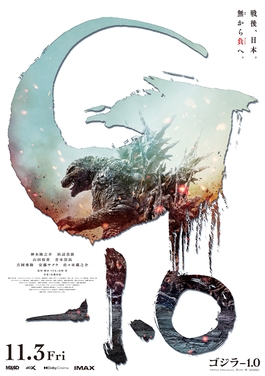It’s been almost 70 years since Ishirō Honda’s original Gojira (ゴジラ) appeared with its kaiju-based metaphor for atomic weapons to successfully begin Tōhō’s Godzilla franchise. Over the ensuing years and its 32 Tōhō sequels prior to 2023 (as well other Godzilla appearances in films from other studios), the monster quickly lost its horror, and the films either abandoned or inferiorly handled any sociopolitical allegory. Godzilla became cheesy good fun. There’ve been subsequent attempts to reboot Godzilla in ways that try to balance kaiju action and modern special effects with more artistry and depth. These have had various, though usually middling, success.

If you haven’t yet seen Gojira Mainasu Wan (ゴジラマイナスワン), then hopefully you have at least seen the widespread acclaim from audiences, critics, Godzilla fans, and general viewers alike. Godzilla Minus One is exceptional, a movie worth seeing even if you haven’t seen Godzilla or aren’t a general fan of the countless sequels. Writer and director Takashi Yamazaki does the best job imaginable in balancing art and entertainment in his movie, infusing it with both thematic depth and relatable emotion. These all resonate to audiences with the support of a powerfully nuanced score by Naoki Satō and a talented cast.
The film begins in 1945, just days prior to the close of World War II, with Japan collectively at its (seemingly) lowest point. Hesitating to sacrifice himself for a lost cause, kamikaze pilot Kōichi Shikishima (Ryunosuke Kamiki) lands on Odo Island for repairs, claiming mechanical issues with his plane that would prevent him from fulfilling his mission. The mechanics find no issue with the plane, but seem to forgive Shikishima for his actions amid their mourning of the lost war. However, that night a dinosaur-like monster that the locals name Gojira comes from the sea and attacks the base. The mechanics plead with Shikishima to get into his plane and use his skills to shoot the monster dead. However, the Shikishima again locks up in fear and all the mechanics but Sōsaku Tachibana (Munetaka Aoki) are slaughtered, with Shikishima himself fleeing in terror before being knocked unconscious.
Shikishima returns home a pariah for his condition of being a kamikaze pilot who lived, with that shame only intensified by his inaction that led to the mechanics being slaughtered. Finding Tōkyō decimated and his parents killed by bombings, Shikishima has little reason to live with the enormous pain of his trauma. Only his continual fear of actual death seems to keep him going. That is, until he meets Noriko Ōishi (Minami Hamabe), a woman whose parents who have also died and who has rescued an orphaned baby named Akiko (Sae Nagatani). Along with a neighbor, Sumiko Ōta, who lost her husband and children (Sakura Ando), this found family begins the process of living amid survivor’s guilt, trying to rebuild as the nation in whole follows suit. Shikishima finds work with a minesweeper team on the Shinsei Maru, consisting of captain Yōji Akitsu (Kuranosuke Sasaki), former Naval weapons engineer Kenji Noda (Hidetaka Yoshioka), and the young Shirō Mizushima (Yuki Yamada), who yearns for the opportunity to fight for his people and nation like his elders got to do during the war. Meanwhile, Ōishi finds office work in Ginza, a neighborhood in the Chūō ward of Tōkyō.
As the years pass, the United States begins to distance itself from aiding Japan to devote its energies to stand-offs with the Soviet Union, and to continue its development and testing of nuclear armaments. Similar to the original 1954 film, tests in the Bikini Atoll of the Marshall Islands disturb the local Odo Island monster Gojira, and the radiation leads to mutations that increase his size, forcing him to extend his range toward Japan. Just as the future seems potentially hopeful for Shikishima to move on from the war and his guilt, Gojira begins attacking ships near Japan’s coast, and then makes landfall in Ginza, killing thousands amid destruction that pushes Japan and Shikishima past what they thought was their nadir. With no US support and a floundering government that seems more concerned with keeping the monster attack under wraps, the private citizens of Tōkyō—former wartime fighters and noncombatants alike—decide that they must act to combat the threat. The scientific Noda comes up with a plan to neutralize and potentially destroy Gojira, one that’s based on more noble principals than the battles they’ve all just come from fighting, one that seeks to preserve life rather than demand its sacrifice at all costs, one that allows them to live for tomorrow.
While the monster of Gojira Mainasu Wan retains Honda’s metaphor for the dangers of nuclear weapons, Yamazaki folds in its embodiment of guilt and shame. Yamazaki masterfully weaves the threads of this theme throughout the plot of the movie, from the individual level of Shikishima to the collective level of the Japanese people. The defeat of Gojira is really about processing and overcoming post-traumatic emotions. Though there is never any evidence to deny Gojira’s existence in the film as a realistic, physical threat, Yamazaki frequently has Shikishima questioning his sanity and openly wondering if he is dreaming this all, or inventing the monster and this scenario in his mind in the last moments before death on Odo Island or mid-kamikaze run. The characters themselves recognize the allegory here, but still most come to terms psychologically on how to best deal with it, both in their minds and in terms of actual kaiju threat.
Along with the thematic element of guilt, Yamazaki also uses the movie to explore the failure of governments to respond to threats. One wonders how much of this came later in the film’s development through the delays from the SARS-CoV-2 pandemic, or if that broad event just nicely fits in with the norm from the days of World War II onward. Though it’s explored or developed in far less detail than the theme of guilt, this element of the common people rising up to handle responsibility that governments ignore inspires some hope. Yamazaki also does explore an offshoot of this general theme of “coming together” at the level of family and fatherhood through Shikishima’s relationship with Ōishi, Akiko, and Ōta or the work relationship between those on the Shinsei Maru.
The most significant criticism one could likely make of Gojira Mainasu Wan would be in how firmly by-the-books it is in terms of plot development and its twists. Careful attention to how Yamazaki is playing with audience emotion will telegraph most surprises with easy predictability. And the ultimate defeat (though of course not completely) of Gojira at the end of the film proceeds exactly how things are lined up to go. The fact remains that none of this really matters. The familiarity and expectation prove comforting and the action sequences are entertainingly compelling despite knowing each step to come. And despite knowing the emotional manipulation is there, one is likely to get choked up all the same. Good pacing and the doses of those weighty thematic elements also help complement it all.
The aforementioned musical score by Satō also goes a long way in helping audiences feel with the movie’s characters. Satō successfully blends the musical themes of Godzilla’s character, and related motifs from prior beloved films, with new compositions. The score likewise combines older styles of minimalism with modern ones (such as the unsettling strings that underlie the dread anticipation of Gojira’s appearances) and Western harmonies with ones that bring to mind Eastern traditions. With much of the film’s plot taking place on the sea, the influence of Spielberg’s Jaws on Yamazaki’s Gojira Mainasu Wan is evident. Consistent with this, Satō’s score calls to mind the best qualities of Williams’ minimalistic theme without being overtly analogous.
Another aspect of the film to note would be the superb writing of its cast and the interpretation of their performances. Each of the characters could be reduced to tropes seen throughout world cinema and most particularly in Japanese movies. But they also each extend beyond those tropes in how well the cast plays them as more serious than simple caricatures and in how the script provides all with some sort of arc, even the secondary players. Take Noda, for instance. He’s a science and technology geek at his core. Yet while the cheesier Godzilla films might use such a character as fodder for nerd jokes and clichés, Yamazaki and actor Yoshioka make Noda into a reasoned man of passion, intelligence, and inspiration. He wields both science and good-natured humor, yet also is shown wracked by doubts and uncertainty that bring fear even amid his resolutions to do all he can.
The term kaiju literally means “strange beast,” but has come to be more associated with the idea of “giant monster.” Yet, these giant monsters have never really seemed particularly horrific. Honda’s original film arguably could be considered horror, but Yamazaki’s film fits within the genre even more so. Gojira’s embodiment of guilt, with all its uncaring violence and the utterly indiscriminate trauma it inflicts on people, represents a stunning force of horror, a chaos manifestation that must be acknowledged and faced. Gojira Mainasu Wan demonstrates how such frightening and tumultuous uncertainty can be battled through collective and nurturing ways within found families and society at large. Our world faces many Gojiras. It’s a message and narrative we all need to hear.







